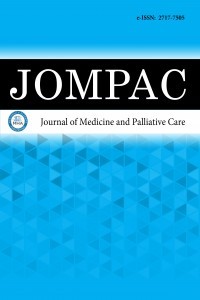Relationship between HALP score and 28-day mortality in very elderly geriatric critically ill patients with acute ischemic stroke
HALP Score, Very Elderly Geriatric Patient, Acute Ischemic Stroke
Relationship between hemoglobin, albumin, lymphocyte, and platelet (HALP) score and 28-day mortality in very elderly geriatric critically ill patients with acute ischemic stroke
___
- Bouffioulx E, Arnould, Thonnard JL. Satisfaction with activity and participation and its relationships with body functions, activities, or environmental factors in stroke patients. Arch Phys Med Rehabil 2011; 92: 1404-10.
- Bonita R. Epidemiology of stroke. Lancet 1992; 339: 342-4.
- Shichita T, Sakaguchi R, Suzuki M, Yoshimura A. Post-ischemic inflammation in the brain. Front Immunol 2012; 3: 132.
- Esenwa CC, Elkind MS. Inflammatory risk factors, biomarkers and associated therapy in ischaemic stroke. Nat Rev Neurol 2016; 12: 594-04.
- FOOD Trial Collaboration. Poor nutritional status on admission predicts poor outcomes after stroke: observational data from the FOOD trial. Stroke 2003; 34: 1450-56.
- Baird AE. The forgotten lymphocyte: immunity and stroke. Circulation 2006; 113: 2035-6.
- Reininger AJ, Bernlochner I, Penz SM, et al. A 2-step mechanism of arterial thrombus formation induced by human atherosclerotic plaques. J Am Coll Cardiol 2010; 55: 1147-58.
- Milionis H, Papavasileiou V, Eskandari A, D'Ambrogio-Remillard S, Ntaios G, Michel P. Anemia on admission predicts short- and long-term outcomes in patients with acute ischemic stroke. Int J Stroke 2015; 10: 224-30.
- Guo Y, Shi D, Zhang J, et al. The hemoglobin, albumin, lymphocyte, and platelet (HALP) score is a novel significant prognostic factor for patients with metastatic prostate cancer undergoing cytoreductive radical prostatectomy. J Cancer 2019; 10: 81-91.
- Peng D, Zhang CJ, Tang Q, et al. Prognostic significance of the combination of preoperative hemoglobin and albumin levels and lymphocyte and platelet counts (HALP) in patients with renal cell carcinoma after nephrectomy. BMC Urol 2018; 18: 20.
- Stroke−1989. Recommendations on stroke prevention, diagnosis, and therapy. Report of the WHO Task Force on Stroke and other Cerebrovascular Disorders. Stroke 1989; 20: 1407-31.
- Xu SS, Li S, Xu HX, et al. Haemoglobin, albumin, lymphocyte and platelet predicts postoperative survival in pancreatic cancer. World J Gastroenterol 2020; 26: 828-38
- UpToDate. Initial assessment and management of acute stroke Available online: https://www.uptodate.com/contents/initial-assessment-and-management-of-acute-stroke. 2023
- Brouns R, De Deyn PP. The complexity of neurobiological processes in acute ischemic stroke. Clin Neurol Neurosurg 2009; 111: 483-95.
- Kellert L, Martin E, Sykora M, et al. Cerebral oxygen transport failure?: decreasing hemoglobin and hematocrit levels after ischemic stroke predict poor outcome and mortality: STroke: RelevAnt Impact of hemoGlobin, Hematocrit and Transfusion (STRAIGHT)–an observational study. Stroke 2011; 42: 2832-7.
- Chang JY, Lee JS, Kim BJ, et al. Influence of hemoglobin concentration on stroke recurrence and composite vascular events. Stroke 2020; 51: 1309-12.
- Barlas RS, Honney K, Loke YK, et al. Impact of hemoglobin levels and anemia on mortality in acute stroke: analysis of UK Regional Registry Data, Systematic Review, and Meta-Analysis. J Am Heart Assoc 2016; 5: e003019.
- Eckart A, Struja T, Kutz A, et al. Relationship of nutritional status, inflammation, and serum albumin levels during acute illness: a prospective study. Am J Med 2019; 133: 713-22.e7.
- Dziedzic T, Slowik A, Szczudlik A. Serum albumin level as a predictor of ischemic stroke outcome. Stroke 2004; 35: e156-e8.
- Kim J, Song TJ, Park JH, et al. Different prognostic value of white blood cell subtypes in patients with acute cerebral infarction. Atherosclerosis 2012; 222: 464-7.
- Cankar Dal H, Yalnız KY, Tosun D,et al. Platelet-to-lymphocyte ratio and mean platelet volume-to-platelet count ratio for predicting mortality in critical COVID-19 patients. J Health Sci Med 2022; 5: 1512-7.
- Yang M, Pan Y, Li Z, et al. Platelet count predicts adverse clinical outcomes after ischemic stroke or TIA: subgroup analysis of CNSR II. Front Neurol 2019; 10: 370.
- Başlangıç: 2020
- Yayıncı: MediHealth Academy Yayıncılık
Hülya TOPÇU, İsmail SEZİKLİ, Duygu TUTAN, Hüseyin KÖSEOĞLU, Ramazan TOPCU
Jülide SAYİN KART, Ummahan DALKİLİNC HOKENEK
Pankreas kanserli hastalarda sağkalıma etki eden prognostik faktörler: tek merkez deneyimi
Abdullah KAHRAMAN, Güler ERASLAN DOĞANAY
Obezite geliştirme riskini öngörebilecek bazı ölçüm parametrelerinin analizi: klinik bir çalışma
Sercan BULUT ÇELİK, Pakize Gamze ERTEN BUCAKTEPE, Ülkü BULUT BATUR, İbrahim Umud BULUT
Hüseyin Furkan ÖZTÜRK, Gonca ALTINIŞIK İNAN, İpek Pınar ARAL, Suheyla AYTAÇ ARSLAN, Sedef GÖKHAN AÇIKGÖZ, Havva BEYAZ, Yılmaz TEZCAN
COVID-19, DEHB'li çocuk ve ergenlerin ruh sağlığı ve yaşam kalitesini etkiledi mi?
Kronik obstrüktif akciğer hastalığında gevşeme egzersizlerinin dispne ve uyku kalitesine etkisi
Hülya IŞIKEL, Sebahat GENÇ, Özge ORAL TAPAN, Özge İPEK DONGAZ
